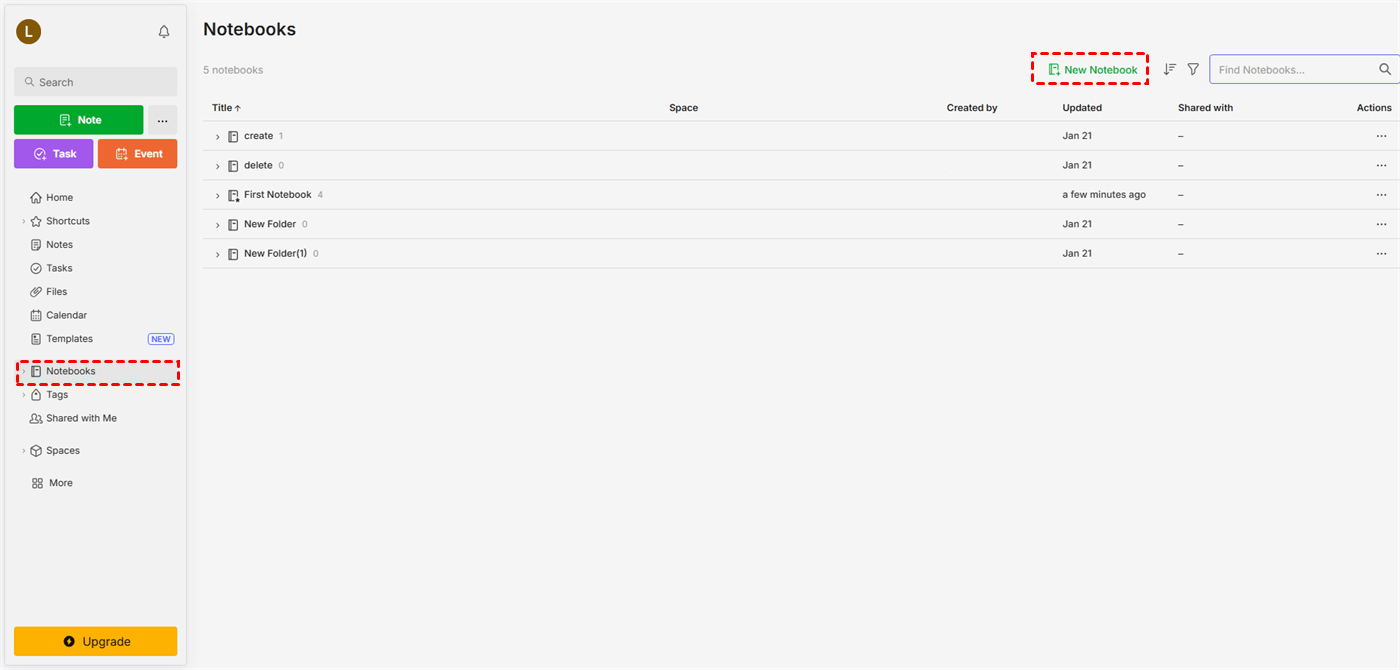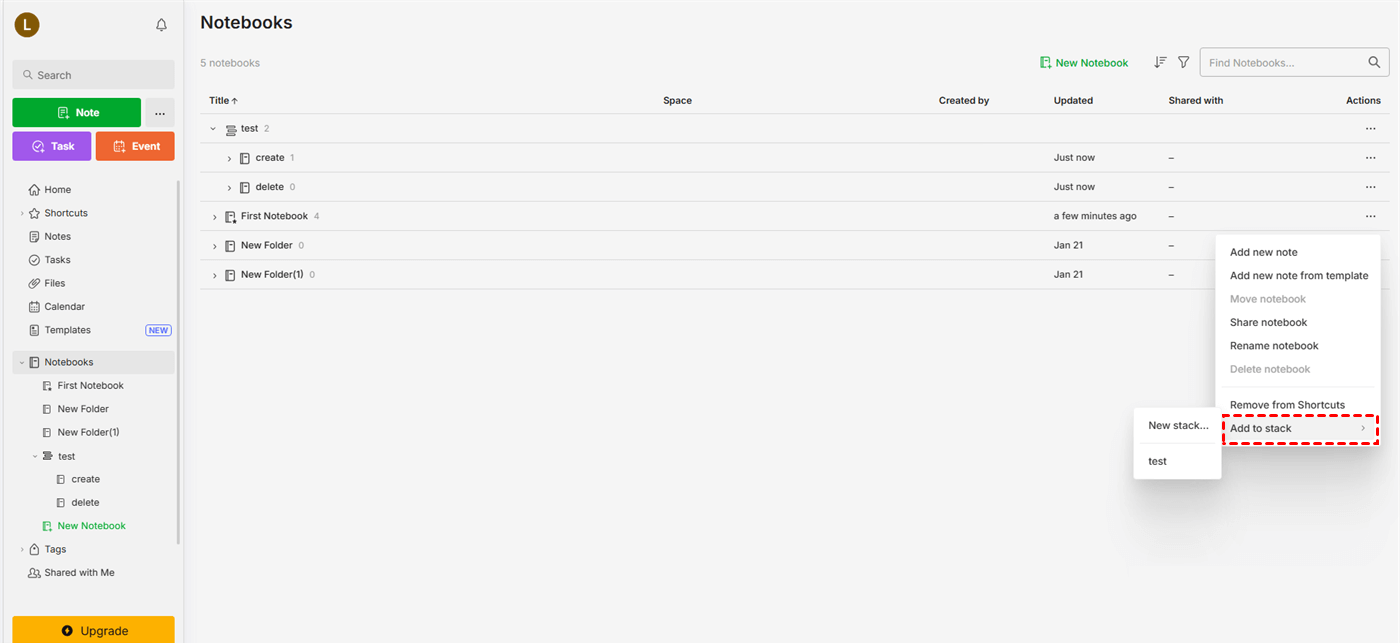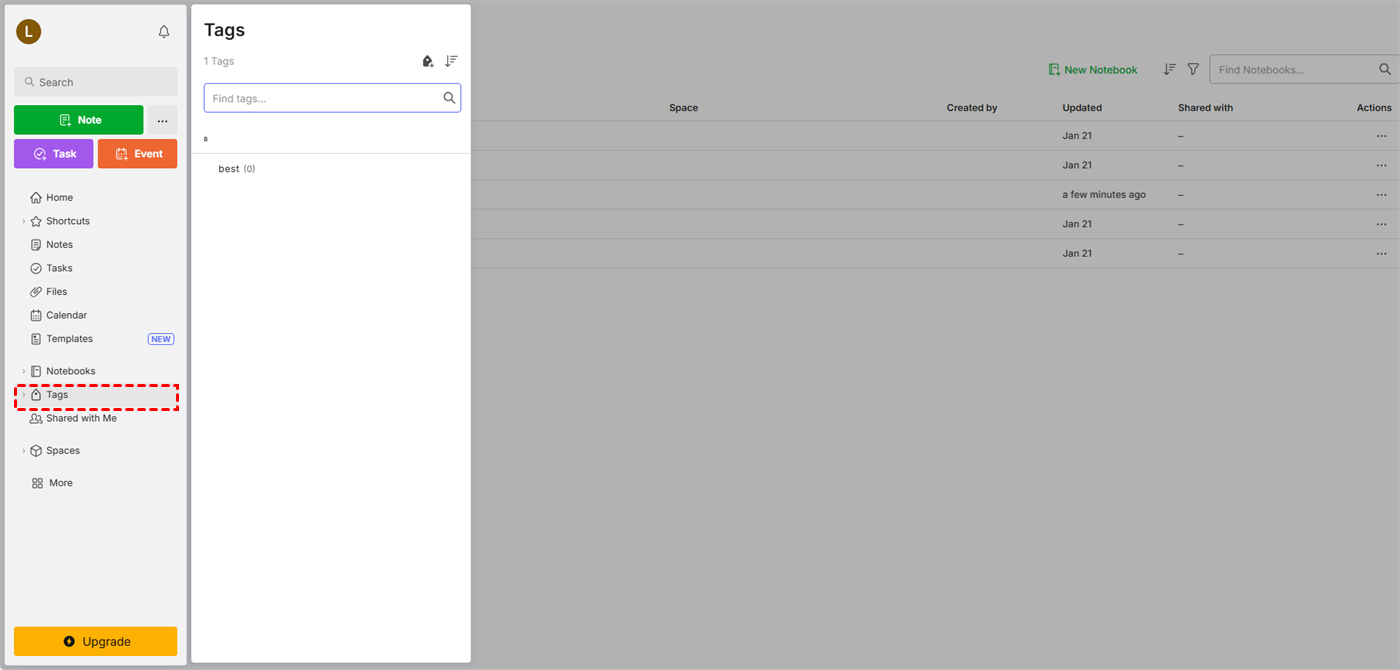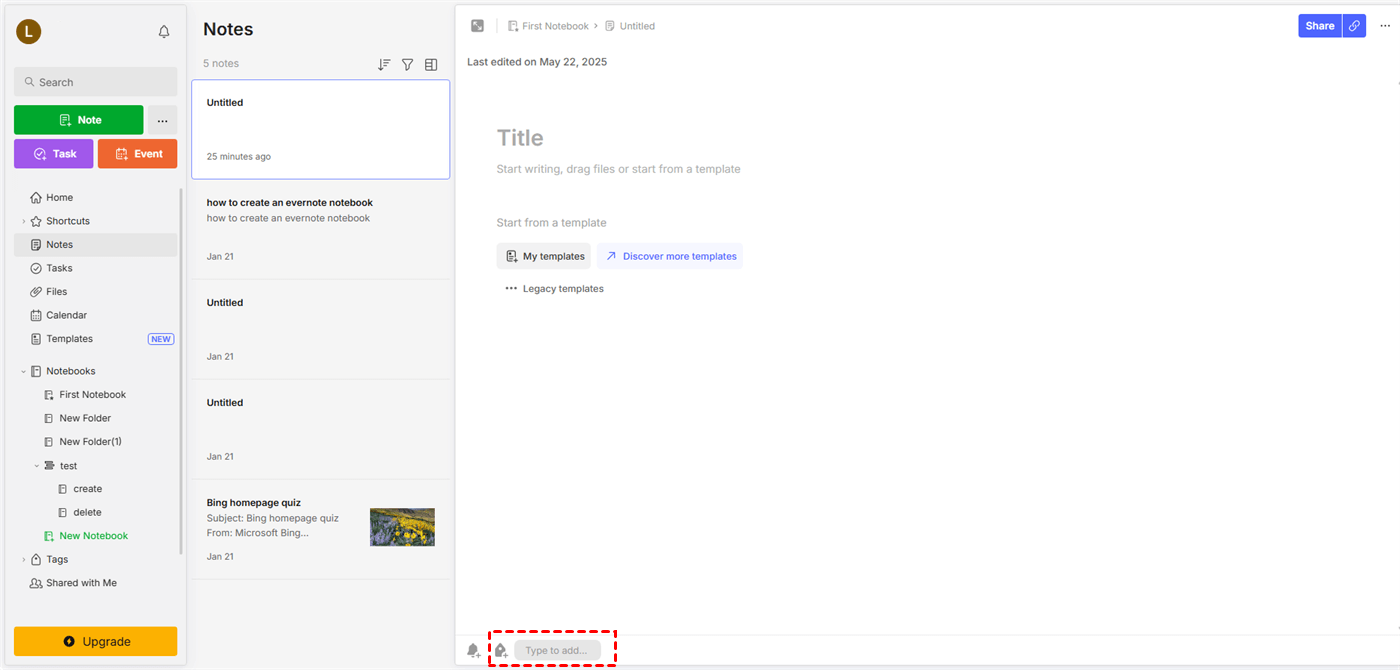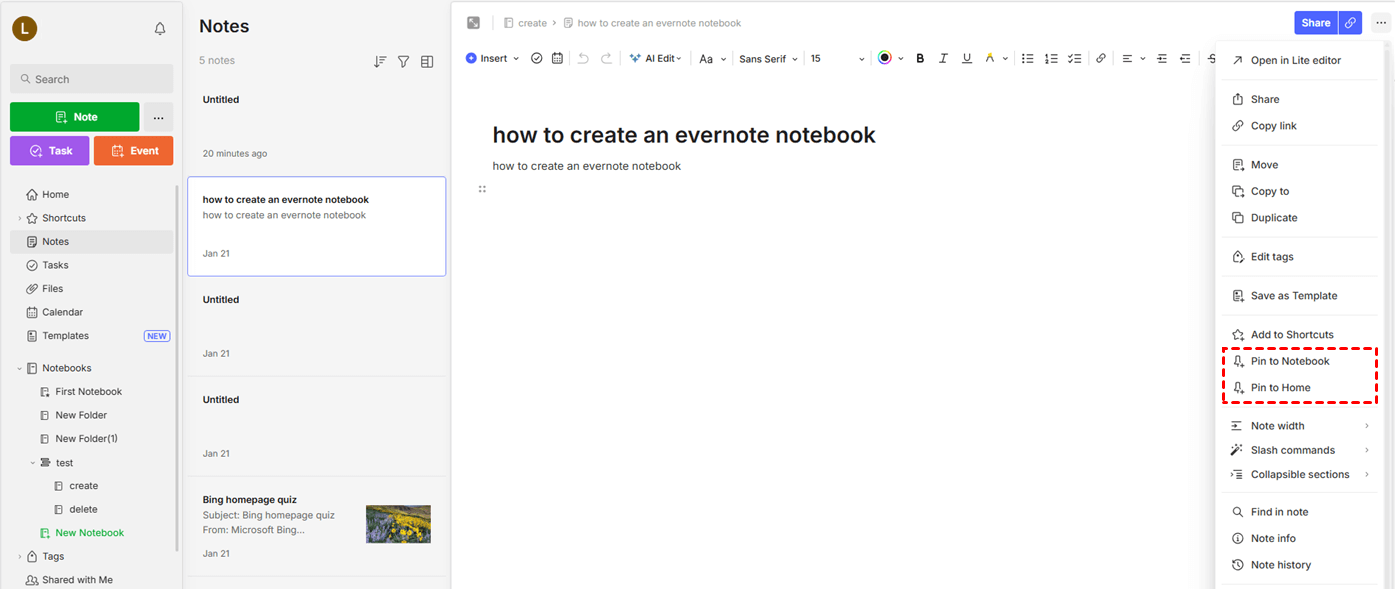Overview of Evernote Folder Structure
Knowing the folder structure of Evernote is a necessary preparation for you to learn how to organize notes in Evernote efficiently. It will make all the steps clearer and easier to understand.
Evernote uses a flexible organizational structure and hierarchical system to help you organize and search your notes efficiently. It offers a simpler, more effective approach based on notes, notebooks, and stacks, with powerful tags and search capabilities. This is different from traditional file systems with deeply nested folders. Therefore, instead of learning how to create folder in Evernote, it is more likely to create a notebook or stack.
1. Notes
Notes are the specific content you create in Evernote at the most granular level. They include:
- Text or plain text with formatting, including images, tables, checklists, etc.
- The Web Clipper is used to clip web pages.
- Audio recordings.
- Scanned documents (with searchable text using OCR).
- PDF files and other attachments.
- Handwritten notes (if you take digital photos).
Each note is contained in a single notebook.
2. Notebooks
Evernote uses notebooks as the primary way to organize related notes. Think of them as similar to file folders. You can create notebooks for:
- Specific projects.
- Data categories.
- Aspects of your life.
- Clients or departments.
Important features of Notebooks:
⭐ One-to-one relationship: A note can only be saved in a folder at the same time.
⭐ Sharing: You can collaborate on all of the notes in a notebook by sharing entire notebooks with other Evernote users.
⭐ Default Notebook: New notes created without a notebook selection typically are saved in a "Default Notebook" (often referred to as "Inbox" or "My Notebook"), which you can modify.
3. Stacks (Notebook Grouping)
A higher level of organization is stacks which let you group related notebooks together. They give you a way to organize your sidebar and give your notebooks a two-level hierarchy.
Important features of Stacks include:
⭐ Notebooks only: Stacks can only contain notebooks; you cannot directly put notes into a stack.
⭐ No nested stacks: It is not possible to build one stack inside another. The hierarchy is: Note > Notebook > Stack.
⭐ Personal organization: Stacks are not directly shareable and are mainly for your own personal organization. When you share a notebook inside a stack, the entire stack is not shared—just that particular notebook.
⭐ Reduction of visual clutter: If you have a lot of notebooks, they are especially helpful for clearing out your sidebar.
4. Tags
A strong and adaptable method for classifying notes across notebooks or adding extra context outside of the notebook structure is to use tags. A note can have more than one tag.
Important features of Tags:
⭐ Cross-notebook categorization: Although a note can be saved in a notebook, you can use the same tag for relevant notes in different notebooks.
⭐ Specifics: Tags can be used to more precisely describe the content or status of a note.
⭐ Hierarchical tags: A hierarchical tag structure can be created with Evernote's support for nested tags (e.g., "Areas > Finances > Taxes"). In contrast to the notebook hierarchy, this offers a nearly infinite level of classification.
⭐ Searchability: Notes can be easily located using particular criteria thanks to tags' high searchability.
5. Search
Evernote's robust search is an essential component of its organizational philosophy, even though it isn't a "folder" in the conventional sense. Since they can easily locate anything using keywords, tags, dates, and other sophisticated search parameters, many Evernote power users rely heavily on search and occasionally even opt for a flat notebook structure. Evernote's OCR feature increases the retrieval power of images and PDFs by making text within them searchable.
How to Organize Notes in Evernote Efficiently
Now you know what you can use to organize your notes in Evernote. Here are some tips that may give you a hint to create your own structure.
1. Use Notebooks for Broad Categories
Group related notes into notebooks such as:
- Ideas
- Receipts
- Work Projects
- Study Notes
Tip: If there are too many notebooks, it may be more confusing. Therefore, you can create folders aiming for functions, not volume.
2. Use Stacks to Group Notebooks
Stacks help organize multiple notebooks under one theme, such as:
Stack: Work
> Project A
>> Meeting Notes
3. Leverage Tags for Cross-Organization
► Tags let you sort notes across notebooks. Example tags: #urgent, #2025planning, #finance, #readlater
► It is recommended to add multiple tags to one note for flexible filtering.
4. Name Notes Clearly and Consistently
When you name a note, you can give it a clear name by using prefixes or formats, such as:
- 2025-05-22 Meeting with Sarah
- Recipe - Thai Curry
- Book Summary - Atomic Habits
5. Pin Important Notes or Use Shortcuts
With time passing by, you may create a lot of notes, notebooks, or tags on Evernote. If you want to find your frequently used ones, you can add them to “Shortcuts”. Otherwise, you can pin this note to "Home" or "Notebooks".
6. Use Tasks, Checklists, and Reminders
► You can set reminders on notes with due dates in case you forget the deadline of important tasks.
► It is a good idea to use checklists to track progress or to-dos.
7. Archive or Delete Old Notes
► If a note is not that useful now but you do not want to delete it, you can move outdated notes to an "Archive" notebook.
► Since Evernote has limitations for notes, notebooks, and storage, you can also delete what you no longer need to reduce clutter and save storage.
8. Regularly Review and Update Your Structure
You can spare some time and do a monthly check-up to re-tag, rename, or reorganize. Always keep your system clean and relevant is helpful to search notes.
Conclusion
Now you must know how to organize notes in Evernote efficiently by understanding the structure of its folders and getting some tips for well-organizing your notes.
Moreover, if you want to back up your Evernote notes to other clouds, such as Evernote to OneDrive, Google Drive, Dropbox, iCloud Drive, or pCloud, you can try MultCloud to automatically sync Evernote notes with a cloud drive in real-time.

- Cloud Transfer: Transfer Evernote notes or notebooks to another cloud without downloading and uploading.
- Cloud Sync: Real-Time sync Evernote with Google Drive or other clouds to update the added or modified content constantly.
- Cloud Backup: Directly back up notes or notebooks from Evernote to other clouds. When you want to restore the backups, you can choose different versions to make it.
- Offline Transfer: MultCloud tasks can run offline. Therefore, after creating a transfer/sync/backup task, you can just close the task window or your device and let the task run in the background.
- Schedule: If you want a task to run daily/weekly/monthly at a fixed time, you can schedule the task.
MultCloud Supports Clouds
-
Google Drive
-
Google Workspace
-
OneDrive
-
OneDrive for Business
-
SharePoint
-
Dropbox
-
Dropbox Business
-
MEGA
-
Google Photos
-
iCloud Photos
-
FTP
-
box
-
box for Business
-
pCloud
-
Baidu
-
Flickr
-
HiDrive
-
Yandex
-
NAS
-
WebDAV
-
MediaFire
-
iCloud Drive
-
WEB.DE
-
Evernote
-
Amazon S3
-
Wasabi
-
ownCloud
-
MySQL
-
Egnyte
-
Putio
-
ADrive
-
SugarSync
-
Backblaze
-
CloudMe
-
MyDrive
-
Cubby

